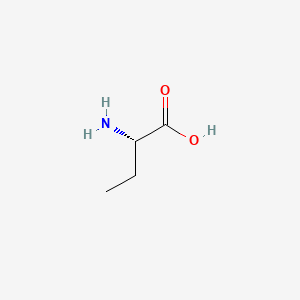| MeSH term | MeSH ID | Detail |
|---|---|---|
| Alcoholism | D000437 | 27 associated lipids |
| Diabetes Mellitus | D003920 | 90 associated lipids |
| Glioma | D005910 | 112 associated lipids |
| Liver Diseases, Alcoholic | D008108 | 13 associated lipids |
| Alcohol-Induced Disorders | D020751 | 1 associated lipids |
L-2-aminobutyric acid
L-2-aminobutyric acid is a lipid of Fatty Acyls (FA) class. The involved functions are known as Analyte, Noise and drug catabolism. The associated genes with L-2-aminobutyric acid are butyrine.
Cross Reference
Introduction
To understand associated biological information of L-2-aminobutyric acid, we collected biological information of abnormalities, associated pathways, cellular/molecular locations, biological functions, related genes/proteins, lipids and common seen animal/experimental models with organized paragraphs from literatures.
What diseases are associated with L-2-aminobutyric acid?
There are no associated biomedical information in the current reference collection.
Possible diseases from mapped MeSH terms on references
We collected disease MeSH terms mapped to the references associated with L-2-aminobutyric acid
PubChem Associated disorders and diseases
What pathways are associated with L-2-aminobutyric acid
There are no associated biomedical information in the current reference collection.
PubChem Biomolecular Interactions and Pathways
Link to PubChem Biomolecular Interactions and PathwaysWhat cellular locations are associated with L-2-aminobutyric acid?
There are no associated biomedical information in the current reference collection.
What functions are associated with L-2-aminobutyric acid?
Related references are published most in these journals:
| Function | Cross reference | Weighted score | Related literatures |
|---|
What lipids are associated with L-2-aminobutyric acid?
There are no associated biomedical information in the current reference collection.
What genes are associated with L-2-aminobutyric acid?
Related references are published most in these journals:
| Gene | Cross reference | Weighted score | Related literatures |
|---|
What common seen animal models are associated with L-2-aminobutyric acid?
There are no associated biomedical information in the current reference collection.
NCBI Entrez Crosslinks
All references with L-2-aminobutyric acid
Download all related citations| Authors | Title | Published | Journal | PubMed Link |
|---|---|---|---|---|
| Monticello DJ et al. | Isoleucine synthesis by Clostridium sporogenes from propionate or alpha-methylbutyrate. | 1984 | J. Gen. Microbiol. | pmid:6726176 |
| Joseph B et al. | Studies on the enhanced production of extracellular lipase by Staphylococcus epidermidis. | 2006 | J. Gen. Appl. Microbiol. | pmid:17325444 |
| Petruzziello A et al. | Defective insulin action in fibroblasts from noninsulin-dependent diabetes mellitus patients with Gln1152 insulin receptor mutation. | 1993 | J. Clin. Endocrinol. Metab. | pmid:8393885 |
| PaÅŸca SP et al. | One carbon metabolism disturbances and the C677T MTHFR gene polymorphism in children with autism spectrum disorders. | 2009 | J. Cell. Mol. Med. | pmid:19267885 |
| Jarboe LR et al. | Metabolic engineering for production of biorenewable fuels and chemicals: contributions of synthetic biology. | 2010 | J. Biomed. Biotechnol. | pmid:20414363 |
| Fitzpatrick PF and Massey V | The kinetic mechanism of D-amino acid oxidase with D-alpha-aminobutyrate as substrate. Effect of enzyme concentration on the kinetics. | 1982 | J. Biol. Chem. | pmid:6127341 |
| Karim CB et al. | Role of cysteine residues in structural stability and function of a transmembrane helix bundle. | 2001 | J. Biol. Chem. | pmid:11477077 |
| Wei G et al. | Through the looking glass, mechanistic insights from enantiomeric human defensins. | 2009 | J. Biol. Chem. | pmid:19640840 |
| Huang K et al. | The A-chain of insulin contacts the insert domain of the insulin receptor. Photo-cross-linking and mutagenesis of a diabetes-related crevice. | 2007 | J. Biol. Chem. | pmid:17884811 |
| Spielman J et al. | Temporal aspects of O-glycosylation and cell surface expression of ascites sialoglycoprotein-1, the major cell surface sialomucin of 13762 mammary ascites tumor cells. | 1987 | J. Biol. Chem. | pmid:3098740 |
